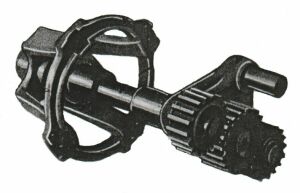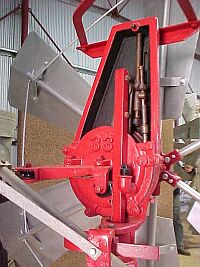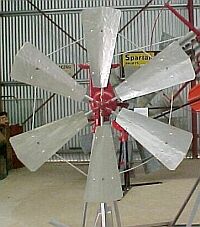


This windmill is a representative of one of James ALSTON's more sophisticated designs and relies on the movement of three gears running inside a annular rack, or inside ring gear, which is fixed in place in the gear box. The drawing of the gears shows the hub shaft, with the hub at one end running through a triangular casting to a pinion gear at the other end of the shaft. The casting has three stub shafts machined on it. The two of these which are either side of the pinion gear act as axles, on which a pair of smaller planetary gears rotate. They are meshed with the central pinion gear which drives them around inside the ring gear. The third stub shaft which has been machined from the gear carrier drives the Pitman arm, which is attached to another casting running up and down a vertical guide rod. This centralises the pumping motion in the mast pipe. It also drives an oil pump to lubricate the mills internals.

The Model 33 is clearly designated as such by the embossed '33' on the separate cast oil cover for the rear of the gearbox sump. The Model 33 can be distinguished from what is taken to be its successor, the 33/40, by the difference in the oil pump tube. The Model 33 employs a curved oil pump tube which fits inside the sump. The 33/40 in comparison has a cylindrical sump in the rear casting of the gearbox, and uses a straight oil pump. These differences are quite obvious from the outside of the gearbox.

The design is thought to have been released on the market in 1933 and presumably was updated in 1940 but this is only a supposition. There appear to have been two wind wheel arrangements available. These were the one illustrated and a version with a conventional wheel. The only feedback on the illustrated version suggests that, in at least the case of the particular example collected, there was a degree of problem experienced with vibration in the wheel. However they were a popular mill in the standard wind wheel configuration and some are still pumping to this day.
The Model 33 was available with wind wheels of 5, 6, 7 and 8 foot and the 33/40 appears to have dropped the 5 foot version. Planetary mills were advertised until at least 1952. Other sizes were also available with different Model numbers. There was a Model 34 in 10 foot, a Model 35 in 12 foot and a Model 36 in 14 foot. Both the Model 34 and the 33/40 used the straight oil pump. Virtually all of the other fittings for this windmill, for furling, blade design, the tail hanger and shock absorbing springs, are of typical Alston type and can be found on the company's other mills of the period.
The model displayed at the Morawa Museum is fitted with "ALSTON's Patent Radial Windwheel". James Alston patented this in 1931, but it probably wasn't fitted onto the actual mills until 1934.